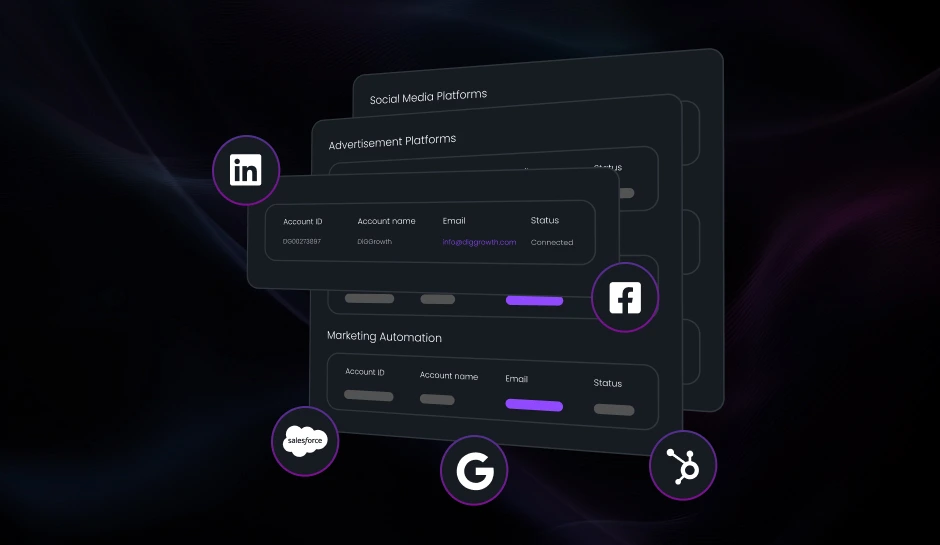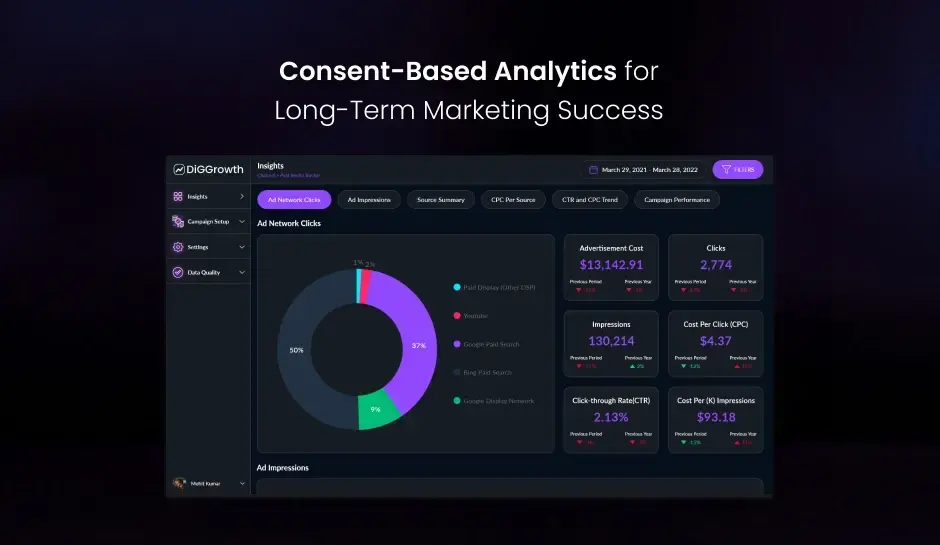
Unlock the Power of Marketing Channel Attribution
Unlock the power of marketing channel attribution to identify top-performing touchpoints, optimize your strategies, and boost ROI with data-driven insights for success.
Marketing channel attribution demystifies the influence each advertising channel holds on consumer behavior. This understanding enables companies to optimize their advertisement investments by correlating marketing efforts with outcomes. Effective marketing attribution leads to the insight that specific touchpoints contribute directly to conversions. As a result, businesses make more informed decisions in allocating their marketing budgets to the most productive channels, thereby maximizing their return on investment.
Attribution lays the groundwork for detailed analytics, pinpointing which marketing tactics triggered consumer actions. Without it, businesses navigate blindly and are unable to identify successful strategies. With it, every customer interaction becomes a data point in a comprehensive analysis. By assigning credit to the right channels, businesses refine their strategies to resonate more profoundly with their target audience.
Types of Attribution Models
Marketing channel attribution leverages various models, each with unique approaches to measuring the impact of different touchpoints in a customer’s journey. Recognizing the nuanced contributions of each interaction, these models either assign credit to a single touchpoint or distribute it across multiple.
Single-Touch Attribution
Single-touch attribution models credit either the initial or final touchpoint in the conversion process:
- First-touch attribution assigns full conversion credit to a customer’s first interaction with a brand. This model acknowledges the touchpoint that sparked initial interest.
- Last-touch attribution gives all credit to the final interaction before conversion, emphasizing the touchpoint that sealed the decision.
Multi-Touch Attribution
In contrast, multi-touch attribution models distribute credit among several interactions:
- Linear model evenly splits credit among all touchpoints, suggesting each interaction has equal influence on the outcome.
- The time-decay model allocates more credit to touchpoints closer to the conversion time, based on the principle that later interactions are typically more influential.
- The U-shaped model attributes greater importance to the first and last interactions, often assigning 40% of the credit to each, with the remaining 20% dispersed among other touchpoints.
- The The W-shaped model expands on the U-shaped approach by also emphasizing the point where a prospect is identified as a lead. It typically attributes 30% credit to the first interaction, 30% to the lead conversion, and 30% to the opportunity conversion, with the final 10% distributed across the journey.
Custom Attribution Models
Organizations may opt for custom attribution models to match their unique business objectives and marketing strategies. These models are shaped by individual company patterns, customer behaviors, and strategic goals, providing a tailored approach to attribution. Tailored models consider specific lifecycle stages, customer touchpoints, and business rules to more accurately attribute conversion credit.
Pro Tip- Choose an attribution model that aligns with your marketing goals and customer journey complexity. For deeper insights, experiment with multi-touch or custom models to capture the full impact of each interaction.
Online vs. Offline Attribution: Navigating the Divide
Discerning the origins of customer engagement in a marketing strategy incorporates both online and offline attribution, yet these worlds present stark contrasts in trackability. Online marketing efforts allow real-time data collection, where clicks, impressions, and interactions feed directly into analytics platforms. Conversely, offline marketing channels such as print ads, billboards, and TV spots lack direct measurability and often require a different approach to gauge effectiveness.
Digital cookies, pixels, and tracking URLs typically facilitate the attribution of online interactions. Offline attribution might involve unique phone numbers, QR codes, or specialized promotional codes to connect a customer’s offline activity to their online actions with a broader margin of error and less granularity.
Challenges in Combining Online and Offline Data
Harmonizing online and offline data streams becomes a complex task. Offline data assimilation into digital marketing analytics platforms does not occur automatically. Marketers usually resort to manual input or batch uploads, which can introduce delays and inaccuracies.
Attributing value across these disparate channels becomes a critical challenge, as marketers must ensure that the data intermingles coherently, respecting the timing and influence of each channel on the customer’s journey. Disjointed datasets can lead to misguided insights and, consequently, to suboptimal strategic decisions.
Pro Tip- Bridge the gap between online and offline attribution by using unified tracking tools like custom QR codes, unique promotional codes, or integrated CRM systems. This enhances data accuracy and offers a comprehensive view of customer journeys across all channels.
The Role of Analytics in Attribution
Analytics provide a lens through which businesses observe and interpret the customer journey. By tracking each touchpoint, companies gain insights into how consumers interact with their brand across multiple channels before converting. Through data, businesses see which channels assist or drive conversions, revealing each marketing tactic’s effectiveness.
Utilizing Analytics to Track the Customer Journey
Every click, view, or interaction gets captured in the analytics. These interactions are essentially breadcrumbs that, when pieced together, map the route customers take from awareness to purchase. Visualizing this data allows marketers to see patterns and preferences that are invaluable in shaping marketing efforts.
How Analytics Help to Assign Credit to Various Channels
Assigning credit to marketing channels requires rigorous analysis. Analytics platforms dissect performance data, enabling the allocation of conversion credit to the responsible channels. Precision in this attribution allows for an evidence-based allocation of marketing resources.
Interactions occur across email, social media, paid ads, and other channels. By harnessing analytics, marketers discern which of these are mere touchpoints and which are conversion drivers. For example, someone might click on a Facebook ad, sign up for a newsletter, and purchase after receiving a promotional email. Analytics illuminate this journey, indicating the pivotal role of the email campaign that led to the conversion despite the journey starting on social media.
- Increased visibility enables more strategic channel investment.
- Data-driven decisions replace guesswork and assumptions in marketing.
- Customer experience improvements are guided by journey analysis.
Analytics do not merely highlight effective channels; they also uncover underperforming areas. Businesses can pivot from strategies that do not yield desired outcomes and invest more into successful initiatives.
Pro Tip- Leverage advanced analytics tools to track cross-channel interactions and conversions in real time. This helps in identifying key touchpoints, refining marketing strategies, and ensuring accurate credit is given to the most impactful channels.
Challenges in Channel Attribution
Marketing channel attribution confronts several obstacles that can distort or complicate understanding a campaign’s performance. Identifying touchpoints and assigning value accurately often stand as the foremost complications, given the sprawling nature of digital ecosystems. Multi-device usage and cross-channel interactions amplify this complexity, as consumers may engage with a brand several times across different platforms before deciding.
Identifying Common Issues Faced in Attribution Efforts
One significant issue is the fragmentation of customer journeys. Unlike the more linear paths of the past, contemporary consumers may start on a mobile app, research further on a desktop, and complete a purchase in-store or via a third-party vendor. Moreover, privacy settings and blockers can restrict access to the data crucial for precise attribution.
How to Overcome These Challenges to Ensure Accurate Tracking
To navigate these hurdles, businesses can adopt deterministic and probabilistic methods, benefiting from accurate user-specific data and pattern-based assumptions where data is less complete. Enhancing data collection with unified tracking technologies bridges gaps between devices and channels. Additionally, constant calibration of attribution models ensures alignment with evolving consumer behaviors and market trends.
- Data integration techniques enable a unified view of the customer journey, allowing for a more coherent interpretation of touchpoints.
- Employing user-centric analytics platforms aids in stitching disparate data sources together, enhancing the clarity of the attribution path.
- Review and adjust the chosen attribution model regularly to account for changes in business strategy, consumer technology use, and media consumption habits.
Coupled with an agile attribution strategy, organizations can adapt to this dynamic landscape. Cross-functional collaboration among marketing, IT, and analytics teams fosters the development of sophisticated attribution mechanisms resilient to channel-related idiosyncrasies. Businesses can achieve an attribution model that reflects their unique marketing ecosystem and supports robust, data-driven decision-making.
Pro Tip- Regularly review and recalibrate your attribution models to stay aligned with changing consumer behaviors and market trends. This ensures your tracking efforts remain accurate and adaptable to evolving customer journeys across multiple devices and platforms.
Privacy and GDPR Compliance in Data Tracking
Navigating the complexities of privacy laws during data collection demands meticulous attention. Since the General Data Protection Regulation (GDPR) took effect, businesses across the European Union and beyond must adhere to stringent data protection standards. This regulation has a global impact, as it applies to all companies that process the personal data of individuals within the EU, regardless of the company’s location.
Navigating the Complexities of Privacy Laws in Data Collection
The landscape of data privacy regulations is intricate. Various jurisdictions impose rules and guidelines, which must be reconciled with a company’s data-tracking efforts. These laws govern how data is collected, stored, processed, and shared. Compliance ensures that personal data is handled legally, fairly, and transparently while affording individuals rights regarding their personal data.
Ensuring GDPR Compliance While Maintaining Effective Attribution
- Data inventory and mapping must be conducted to understand what data is collected, where it comes from, how it’s processed, and who has access to it.
- The legal basis for data processing must be documented, whether consent, legitimate interest, or another GDPR-compliant basis.
- Data subjects are to be provided with clear and comprehensive information about how their data is used, including its role in marketing attribution.
- Opt-in and consent practices must be robust, allowing individuals to make informed decisions regarding their data.
- Data protection measures, such as pseudonymization or encryption, should be integrated to maintain the anonymity of individuals.
- Audits and regular reviews must be performed to ensure ongoing compliance and to adjust practices as needed.
By integrating a diligent privacy and data protection strategy, businesses will uphold the integrity of their marketing channel attribution while fostering consumer trust. Compliance with GDPR and other privacy laws is non-negotiable despite the additional complexities. Adhering to these regulations mitigates the risk of penalties and reinforces companies’ ethical responsibility towards the individuals whose data they leverage for marketing insights.
Measuring ROI Through Attribution Analysis
- Enhanced ROI Accuracy:
- Optimized Budget Allocation:
- Targeted Profitability Boost:
- Data-Driven Strategic Refinements:
- Channel Performance Optimization:
Attribution analysis helps trace each marketing channel’s success, allowing companies to assess investments and strategize budgets effectively.
Data reveals which channels drive conversions, enabling businesses to reallocate funds to the most effective strategies and maximize profitability.
Redirecting investments based on attribution data leads to more lucrative marketing efforts and positive bottom-line financial outcomes.
Attribution analysis informs long-term financial forecasting and resource management, improving financial performance in future periods.
High-performing channels are boosted, while underperforming ones are refined or phased out, ensuring marketing budgets are invested wisely.
Mastering the Martial Art of Marketing Attribution
Grasping marketing channel attribution translates directly to understanding the potency of different marketing tactics in the conversion arsenal. Each touchpoint, a unique maneuver, requires precise credit assignment to inform future campaigns effectively. With a finer comprehension of which channels yield the highest conversion rates, businesses can allocate resources confidently, driving their success.
Attribution stands not alone; it weaves through the customer journey, positioning itself as a beacon for customer-centric strategies. Combining the keen insights from attribution with customer relationship management fortifies a brand’s ability to relate and react to customer needs. The diligence applied to data accuracy ensures that these insights lead to actionable intelligence rather than misguided shots in the dark.
Adaptations in privacy regulations, like GDPR, necessitate a recalibration of data tracking practices. Meanwhile, machine learning and AI are changing the battleground by automating and refining the attribution processes, promising a more dynamic conquest of ROI.
Attribution remains an unwavering ally as each business skirmish unfolds – whether it’s a marketing campaign, a shift in strategy, or a new customer journey path. Its place in marketing is not a passing trend but an evolution in strategic command. Embedding attribution analysis into day-to-day decision-making processes equips businesses with the foresight to act decisively and effectively. The future trends only underscore its escalating value and complexity.
Recognize the influence of each marketing channel and harness the power to sharpen your business strategies. Embrace attribution, and the path toward optimized marketing performance and success is yours to tread.
- Assess and reincorporate insights from your marketing attribution systems to ensure mission-critical decisions are data-driven.
- Engage with the community and share the hurdles in aligning marketing attribution to business goals; collective intelligence fosters progress.
- Consider expert consultancy for a tailored attribution strategy that aligns with your unique business architecture and the ever-evolving marketing landscape.
Key Takeaways
- Effective marketing channel attribution enables businesses to identify high-performing touchpoints, allowing for strategic budget reallocations that maximize ROI.
- Understanding different attribution models—single-touch, multi-touch, and custom—empowers marketers to accurately assess the influence of various interactions in the consumer journey.
- Harmonizing online and offline data for accurate attribution requires robust integration techniques and ongoing calibration of models to adapt to consumer behaviors.
- Navigating privacy regulations, such as GDPR, is critical for ethical data collection and processing. It ensures businesses maintain consumer trust while effectively attributing marketing success.
Want to learn more about marketing channel attribution?
Just write to us at info@diggrowth.com and we’ll get back to you.
Ready to get started?
Increase your marketing ROI by 30% with custom dashboards & reports that present a clear picture of marketing effectiveness
Start Free Trial
Experience Premium Marketing Analytics At Budget-Friendly Pricing.

Learn how you can accurately measure return on marketing investment.
Additional Resources
Integrating Data from Different Channels for a Holistic View of Your Marketing Performance
Who's your ideal customer? Where do they come...
Read full post postGet Your Channels to Play Nice: Integrated Data for Smarter Marketing
If you’re a savvy marketer, you’re living in...
Read full post postConsent-Based Analytics: Ensure Long-Term Marketing Success
As marketers, we want our customers to perceive...
Read full post postFAQ's
Marketing channel attribution assigns credit to the different touchpoints that lead to a customer conversion, helping businesses understand which marketing efforts drive results.
Multi-touch attribution provides a more accurate view of the customer journey by crediting multiple interactions, offering deeper insights into which channels influence conversions.
Common models include first-touch, last-touch, linear, time-decay, U-shaped, and W-shaped models, each assigning credit to touchpoints differently based on their influence in the conversion process.
Attribution helps businesses invest more in effective marketing channels by pinpointing which touchpoints lead to conversions, optimizing resource allocation, and increasing return on investment.
Challenges include fragmented data and limited tracking for offline touchpoints, but integrating both data sources allows businesses to create a cohesive view of the customer journey.
 Richa Bhardwaj
Richa Bhardwaj  Sameer Pawar
Sameer Pawar 

